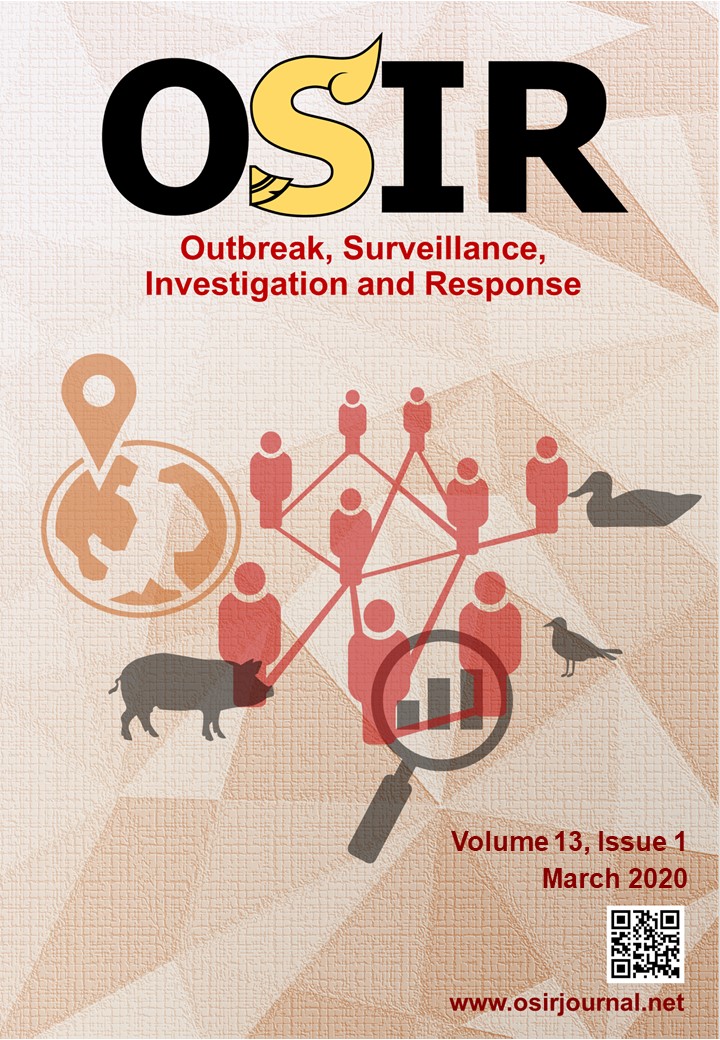Predicting Blood Lead Levels among Children Living in Households Making Fishing Nets with Lead Weights in Phuket and Phang Nga Provinces
DOI:
https://doi.org/10.59096/osir.v13i1.262851Keywords:
child, lead, ThailandAbstract
This study aimed to validate the Integrated Exposure Uptake Biokinetic (IEUBK) model, the computed risk assessment tool, by comparing the predicted blood lead levels and the observed one among children aged 1-7 years old in households making fishing nets, and to develop a predictive model based on environmental lead level in Phuket and Phang Nga Provinces, in the South of Thailand. We identified children in households, which made fishing nets and participated in the Office Disease Prevention and Control 11 Blood Lead Levels Surveillance System (BLLSS). We collected blood lead information, surveillance address and samples from the environment such as soil, water and dust. We calculated the predicted value by using IEUBK program and the site-specific model and compared with observed value to calculate Mean Absolute Error (MAE) and Mean Absolute Percent Error (MAPE). Forty children from different households were recruited. Geometric mean observed blood lead level was 7.6 µg/dL. We found 45% of households with excess lead in surface dust, and 19% in water. The MAE and MAPE of IEUBK model revealed a substantial difference between the observed and predicted values. The site-specific model, including soil, dust in the bed and workwear as predictive variables, had more accuracy predictive capacity. However further study of the IEUBK in other scenarios is needed.
References
Centers for Disease Control and Prevention. Summary of noninfectious conditions and disease outbreaks. MMWR Morb Mortal Wkly Rep 2013;62(No. 54):76-80.
Centers for Disease Control and Prevention. Low Level lead Exposure Harms Children: A Renewed Call for Primary Prevention. 2012.
Siripanich S. Situation of lead exposure among children in Thailand ,1986-2013. Weekly Epidemiological Surveillance Report 2014; 45:529-33
Saetia W. Situation of health effect from environmental pollution in Office of Disease Prevention and Control Region 11. Situation of health effect from environmental pollution in Southern Region of Thailand, January 2015, Nakorn Si Thammarat, Thailand. Unpublished conference paper. Office of Disease Prevention and Control Region11, Surat thaini, 2015.
Griffin S, Marcus A, Schulz T, Walker S. Calculating the interindividual geometric standard deviation for use in the integrated exposure uptake biokinetic model for lead in children. Environmental health perspectives. 1999;107(6):481-7. Epub 1999/05/26.
The United States Environmental Protection Agency. Guidance manual for the IEUBK model for lead in children. 1994. Chapter1: 1-29 Agency for Toxic Substances and Disease Registry. Toxicological profile for lead. Atlanta, GA: U.S. Department of Health and Human Services, Public Health Service.; 2007 [cited 2015 March 23].
Mickle MH. Structure, use, and validation of the IEUBK model. Environmental health perspectives. 1998;106(Suppl 6):1531-4.
Tristan E, Demetriades A, Ramsey MH, Rosenbaum MS, Stavrakis P, Thornton I, et al. Spatially resolved hazard and exposure assessments: an example of lead in soil at Lavrion, Greece. Environmental research. 2000;82(1):33-45. Epub 2000/02/17.
Hassanien MA, Horvath A. lead risk assessment for children in Hungary by predicting their blood lead levels using US EPA integrated Exposure Uptake Biokinetic model. Cent Eur J Public Health. 1999;7(3):155-9. Epub 1999/09/28
Aboh IJK, Sampson MA, Nyaab LA-K, Caravanos J, Ofosu FG, Kuranchie-Mensah H. Assessing levels of lead contamination in soil and predicting pediatric blood lead levels in Tema, Ghana. Journal of Health and Pollution. 2013;3(5):7-12.
Li Y, Hu J, Wu W, Liu S, Li M, Yao N, et al. Application of IEUBK model in lead risk assessment of children aged 61–84 months old in central China. Science of The Total Environment. 2016; 541:673-82.
Wang B, Shao D, Xiang Z, Ye H, Ni W, Yang S, Wu C, Li P, Fu H. Contribution of environmental lead exposure to blood lead level among infants based on IEUBK model. Wei Sheng Yan Jiu. 2011 Jul;40(4) 478-480. PMID: 21861353.
Environmental Protection Agency. Risk assessment guidance for superfund volume I human health evaluation manual (Part A). 1989
Bureau of Occupational and Environmental Diseases. Handbook for childhood lead exposure. Bureau of Occupational and Environmental Disease.Thailand.2014
NIOSH. NIOSH manual of analytical methods (NMAM). Lead by GFAAS Method 7105. Cincinnati, OH: National Institute for Occupational Safety and Health; 1994d.
NIOSH. NIOSH manual of analytical methods (NMAM). Lead by Flame AAS Method 9100. Cincinnati, OH: National Institute for Occupational Safety and Health; 1994c.
Neesanan N, Kasemsup R, Ratanachuaeg S, Kojaranjit P, Sakulnoom K, Padungtod C. Preliminary study on assessment of lead exposure in Thai children agedbetween 3-7 years old who live in Umphang district, Tak Province. J Med Assoc Thai. 2011 Aug;94 Suppl 3: S113-120.
Sahmel J, Hsu EI, Avens HJ, Beckett EM, Devlin KD. Estimation of hand-to-mouth transfer efficiency of lead. Ann Occup Hyg. 2015 Mar;59(2):210–20.
Mushak P. Uses and limits of empirical data in measuring and modeling human lead exposure. Environmental health perspectives. 1998;106(Suppl 6):1467-84.
Hu J., Chen J. W., Zhou Y.K., IEUBK model and its application in China. Journal of Environment and Health.2013; 30:655-658 (article in Chinese)
Li Y, Hu J, Wu W, Liu S, Li M, Yao N, et al. Application of IEUBK model in lead risk assessment of children aged 61–84months old in central China. Science of The Total Environment. 2016; 541:673-82.
Phenrat T, Otwong A, Chantharit A, Lowry GV. Ten-year monitored natural recovery of lead-contaminated mine tailing in Klity Creek, Kanchanaburi Province, Thailand. Environmental Health Perspectives. 2016 Oct;124(10):1511–20.
Downloads
Published
How to Cite
Issue
Section
License
Copyright (c) 2023 Outbreak, Surveillance, Investigation & Response (OSIR) Journal

This work is licensed under a Creative Commons Attribution-NonCommercial-NoDerivatives 4.0 International License.








